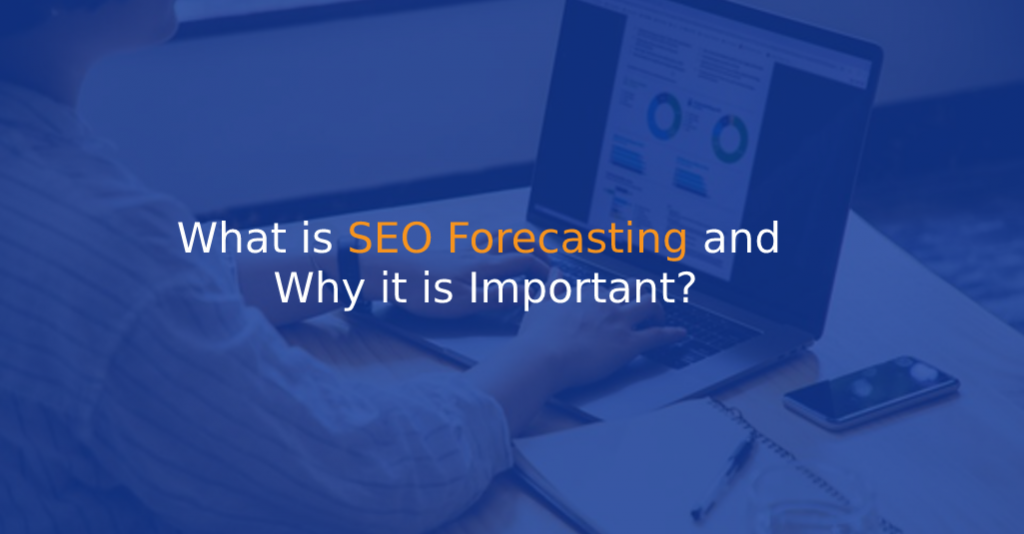To remain competitive in today’s digital age, you must maximize your content. And doing so necessitates the implementation of a search engine optimization (SEO) plan.
SEO forecasting is an essential component of any SEO strategy. Continue reading to discover more about SEO forecasting, why it is important, and how it works!
What is SEO forecasting?
SEO forecasting is the technique of identifying trends in your analytics data from prior search traffic to assist anticipate future outcomes. This data assists your company in determining which initiatives to implement or develop for the best results and value.
Why Does SEO Forecasting Matter?
Now that you have the answer to the question, “what is SEO forecasting?” let’s look at why SEO forecasting is important.
This strategy is vital because it enables you to make better marketing decisions that increase web traffic, leads, and conversions for your business.
Every marketing project you launch has a purpose and an expected return on investment (ROI). It might be difficult to calculate an exact ROI for SEO because so many elements impact the outcomes.

Predicting outcomes based on historical data allows you to better grasp the potential ROI of SEO efforts. It also assists you in developing a content marketing strategy, such as which themes may be most effective in accomplishing a given marketing objective, such as brand recognition.
The Advantages of SEO Forecasting
Aside from more informed decision-making, there are other advantages to SEO forecasting. For example, it can assist you with:
- Determine whether your objectives are reasonable and attainable.
- Spend your marketing cash carefully.
- Learn about your data, what it means, and how to leverage it to your benefit.
How Does SEO Forecasting work?
There are several approaches to SEO forecasting. Which one you use is determined by your objectives.
1. Predicting your keywords' performance
Predicting keyword performance is one of the most popular applications of SEO forecasting. You may use this to predict how your existing keyword rankings will perform in the future and how keywords you wish to rank for may behave.
You’ll need to acquire the necessary information to do so. Assume you are ranked third for a particular word. Looking at the monthly search data for that term can show you how much more traffic you can expect as you go higher.
Following that, you’ll examine the number of visits necessary per conversion. You may now decide whether spending more on that keyword is worth the possible reward.
By examining the traffic patterns for the phrases, you wish to rank for, you may perform the same analysis. This may lead to instant chances.

2. Setting a standard
SEO forecasting may also assist you to comprehend your position in relation to your competition and potential customers.
Making use of your facts and projections as benchmarks allows you to define clear and quantifiable goals. With this framework in place, you can quickly observe where your assets underperformed or outperformed.
These standards are also valuable for managing your team’s and stakeholders’ expectations as they change and improve over time.
3. Predicting traffic growth for your competition
The same tools you use to forecast your predicted keyword performance may also be used to assess your competitors.
When you examine the keywords for which they rank, you can better determine the degree of expenditure required to overcome them for critical phrases. You may also learn how to properly position your business to do so. If you go deep enough, you could even learn about their planned content initiatives!
4. Forecasting your ROI
Because business owners need to know how their marketing plan is paying off, using SEO forecasting to anticipate ROI is arguably the most common way. It’s also important for determining when you could receive such outcomes.
To do so, you must first understand your attribution model and each expense associated with your SEO activities.
In most cases, a single piece of marketing material is insufficient to convert. Throughout the buyer’s journey, your consumers frequently require many touchpoints. The more data you have on touchpoints, the more accurate your forecasts will be.

You should think about the expense of creating a new resource. Combine this with keyword forecasts to calculate how much traffic you can produce and when you’ll repay your spending depending on conversion rates. When you include the expected continued performance, you can better anticipate ROI for your SEO efforts.
5. Predicting opportunity cost
Marketers frequently deal with limited budgets and strive to maximize them. SEO forecasting assists with this by displaying the “real cost” of marketing. A dollar can only be spent once. So, if you invest in Strategy A, there is a cost to Plan B. In other words, by investing more money into A, you may be sacrificing some potential for B.
Ideally, your projections should account for the opportunity cost by employing the same methods of analysis. When you know all of the information, you can make the best decision possible.
You are now ready to begin producing your first SEO projections using any of the strategies listed above! If you’d rather have a professional do it, iStudio Technologies can assist.
iStudio Technologies provides reliable SEO predictions
Our expert team can help you enhance your current results or create a unique SEO plan from start.
To provide our customers with superior SEO results, our content marketing professionals, SEO specialists, and data scientists collaborate.



